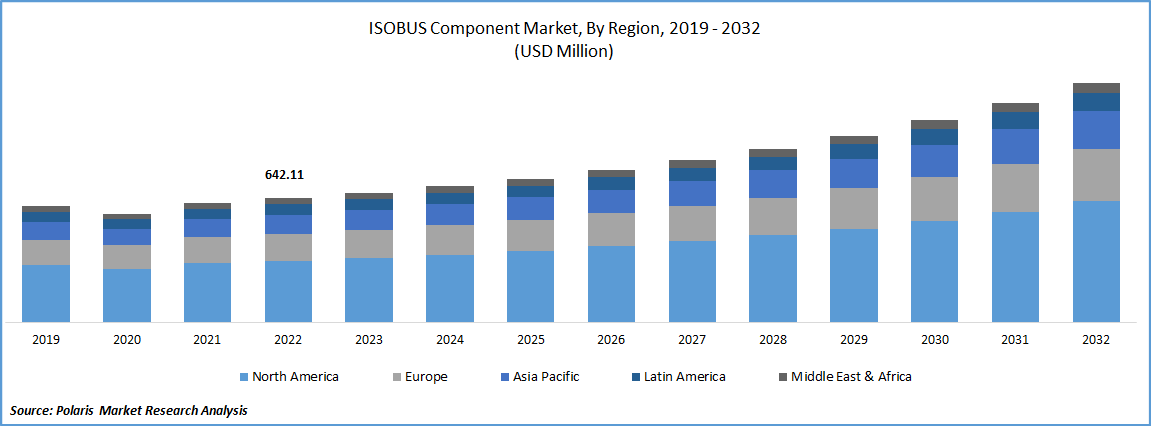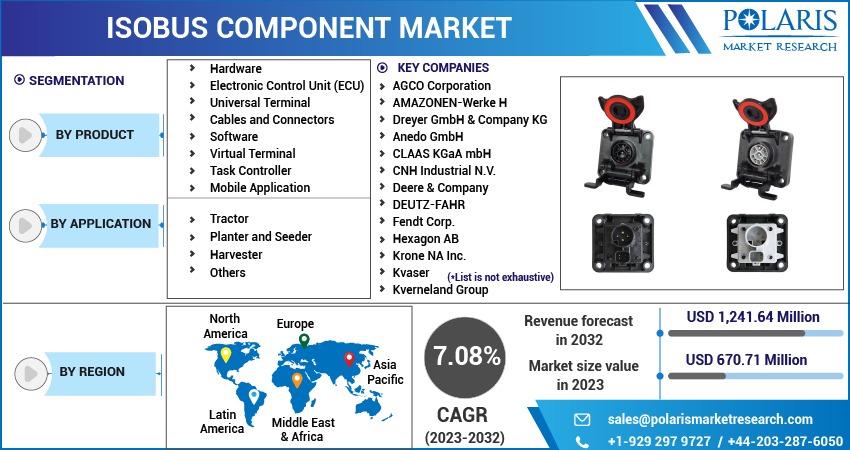
ISOBUS Component Market Share, Size, Trends, Industry Analysis Report
By Product (Hardware, and Software); By Application; By Region; Segment Forecast, 2023- 2032
- Published Date:Jun-2023
- Pages: 117
- Format: PDF
- Report ID: PM3396
- Base Year: 2022
- Historical Data: 2019-2021
Report Outlook
The global ISOBUS component market was valued at USD 642.11 million in 2022 and is expected to grow at a CAGR of 7.08% during the forecast period. The expansion of the market is being supported by rising agricultural production and considerable infrastructure improvements. In addition, the industry is expanding due to rapid urbanization, a growing global population, dwindling arable land, and growing worries about food security. Agricultural and forestry equipment connects to and is controlled via ISOBUS, a standardized communication system. Farmers can control their whole fleet of machinery with only one display and control system owing to the seamless connection that is made possible between various parts, such as sensors, actuators, and controllers. These ISOBUS components also let farmers automate several duties, such as managing precision farming techniques, controlling implements, and monitoring variables like soil moisture or temperature. This decreases the need for manual labor and boosts productivity.

To Understand More About this Research: Request a Free Sample Report
In addition, making informed choices about planting, fertilizing, and harvesting requires collecting and analyzing a lot of data, such as yield maps and meteorological data, using ISOBUS components. The need for ISOBUS components is rising globally since it boosts productivity, lowers costs, and optimizes resource utilization. The ability to quickly link implements made by various firms without switching out harnesses, and monitors, and installing additional control boxes have been a big issue in the agricultural sector.
The rising government efforts for using the ISOBUS are also driving the growth of the market. The ISO 11783 standard addresses this issue. The ISO 11783 standard, also referred to as ISOBUS, outlines a procedure for the interoperability of electronic systems on agricultural and forestry equipment. This virtual ability to become one machine avoids the requirement for numerous control boxes and a variety of different connectors, adaptors, & harnesses. Although practically every European producer of agricultural equipment has accepted ISO 11783, ISO 11783 has just recently become the industry standard for agricultural equipment made in the United States.
Due to COVID-19, the supply chains of most global sectors, including the one for agricultural equipment, were affected. Additionally, a fall in agricultural activity, a temporary suspension of agri-equipment manufacturing facilities, a decline in a manufacturing company and individual investor discretionary income, as well as a slowdown in investment activity, all contributed to a decline in the demand for ISOBUS components internationally. Additionally, a notable change has been observed since the limits and bans have been lifted, as the market is beginning to function once more and will gradually gather up speed in the upcoming years. As manufacturing companies were shut down as part of government efforts to stop the virus' spread, a major impact was seen on the global market for ISOBUS components.

For Specific Research Requirements, Speak to Research Analyst
Industry Dynamics
Growth Drivers
ISOBUS component market is expanding with telematics, GPS, IoT, & data analytics in the ISOBUS components. These cutting-edge technologies allow for remote monitoring and control of equipment as well as the monitoring of its performance and maintenance requirements. In May 2022, Kverneland Group launched the IsoMatch Farmcentre platform which is made for connecting and maintaining tools and control terminals. The platform collects data from the host tractor and the implements, which is communicated, saved, and analyzed through a web application, in conjunction with Kverneland's Isobus-compliant Tellus GO+ and Tellus PRO displays.
Additionally, remote crop operation control is made possible by connecting agricultural machinery to a home computer or smartphone, and highly developed Internet systems (the "Internet of things") can intelligently incorporate data generated by field sensors as well as information gleaned from machinery and equipment. These developments and the application of smart technologies in the agricultural sector will accelerate the growth of the global ISOBUS Components market during the ensuing years.
Report Segmentation
The market is primarily segmented based on product, application, and region.
|
By Product |
By Application |
By Region |
|
|
|
To Understand the Scope of this Report: Speak to Analyst
Hardware segment is expected to witness the fastest growth during forecast period
ECU segment is growing with the fastest CAGR over the forecast period. All important ISOBUS applications in the agricultural sector depend on ECUs that are ISOBUS-enabled, the electronic control unit (ECU) component experienced strong demand compared to other components.
Additionally, many businesses around the world are investing in R&D to offer plug-and-play access to agricultural machinery (tractors, harvesters, etc.) without the requirement of a separate mobile device. In July 2018, The Kubota Corporation has declared its intention to invest €55 million in a new R&D facility in Europe. Kubota will soon invest in a brand-new R&D center in Europe that will serve as the hub for all of the company's tractor-related research initiatives in that region as well as the Competence Centre of Engineering for the agricultural tractor markets. Demand is additionally anticipated to increase during the projection period due to large investments in ISOBUS hardware components.
The demand in North America is expected to witness significant growth during projected timeframe
One of the key elements fueling the market's expansion is an expanding government program to increase agriculture productivity in the area. The United States Department of Agriculture (USDA) announced that it would encourage innovation in American agriculture and raise US agriculture production by 40% by 2050 as part of the Agriculture Innovation Agenda. Additionally, the United States Department of Agriculture (USDA) announced an investment of roughly USD 500 million for the development of agriculture in the region in September 2021 to support the aforementioned project.
Furthermore, it is anticipated that in the next years, demand for ISOBUS components in the North American market would increase due to the large investments made by regional governments to increase agricultural production to fulfill the region's growing food demand. One of Europe's top agricultural producers in France. As a result, it receives significant government subsidies for agriculture, particularly animal rearing. Given that the French government is actively promoting the development of the agricultural sector, France has established itself as a significant market for ISOBUS globally. Additionally, the existence of agricultural implement producers in the nation aids farmers in selecting the best implement for their requirements.
Competitive Insight
Some of the major players operating in the global ISOBUS component market include AGCO Corporation, Anedo GmbH, CLAAS, CNH Industrial., Deere & Company, DEUTZ-FAHR, Fendt Corp., Hexagon, Krone, Kuhn SAS, Kvaser, Kverneland, LEMKEN GmbH, Massey Ferguson, Pöttinger Landtechnik, Small Robot, and SDF Group.
Recent Developments
- In June 2022, Epec introduces the EC44 Agri, a new ISOBUS control unit for agricultural applications. The EC44 Agri is a small, strong control unit with ample internal memory for specific application requirements. The CODESYS 3.5-programmable EC44 Agri is compatible with Epec's extensive library of PLCs, Epec MultiTool, and CANmoon.
- In June 2022, Small Robot Company (SRC) will introduce its agricultural robots to about 50 farms. SRC's robotic farming solution consists of two components. Tom, a plant monitoring robot, and Wilma, the business' artificial intelligence (AI) Advice Engine, are both capable of detecting even the smallest water drops on a plant's leaves. The service maximizes currently available sprayer machinery to cut expenses and inputs.
ISOBUS Component Market Report Scope
|
Report Attributes |
Details |
|
Market size value in 2023 |
USD 670.71 million |
|
Revenue Forecast in 2032 |
USD 1,241.64 million |
|
CAGR |
7.08% from 2023 - 2032 |
|
Base year |
2022 |
|
Historical data |
2019- 2021 |
|
Forecast period |
2023 - 2032 |
|
Quantitative units |
Revenue in USD million and CAGR from 2023 to 2032 |
|
Segments Covered |
By Product, By Application, By Region |
|
Regional scope |
North America, Europe, Asia Pacific, Latin America; Middle East & Africa |
|
Key Companies |
AGCO Corporation, AMAZONEN-Werke H Dreyer GmbH & Company KG, Anedo GmbH, CLAAS KGaA mbH, CNH Industrial N.V., Deere & Company, DEUTZ-FAHR, Fendt Corp., Hexagon AB, Krone NA Inc. (Bernard Krone Holding GmbH & Co. KG), Kuhn SAS (Bucher Industries AG), Kvaser, Kverneland Group (Kubota Corporation), LEMKEN GmbH & Co. KG, Massey Ferguson, Pöttinger Landtechnik GmbH, Small Robot Company (SRC), and SDF Group. |
FAQ's
The global ISOBUS component market size is expected to reach USD 1,241.64 Million by 2032.
Key players in the isobus component market are AGCO Corporation, Anedo GmbH, CLAAS, CNH Industrial., Deere & Company, DEUTZ-FAHR, Fendt Corp., Hexagon, Krone, Kuhn SAS.
North America contribute notably towards the global isobus component market.
The global ISOBUS component market is expected to grow at a CAGR of 7.08% during the forecast period.
The isobus component market report covering key segments are product, application, and region.
